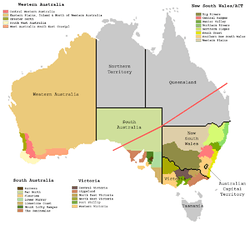Limestone Coast zone (wine)
Limestone Coast zone is a wine zone located in the south east of South Australia. It extends south of a line of latitude approximately in line with Cape Willoughby at the east end of Kangaroo Island and it is bounded by the continental coastline and the border with Victoria. It consists of the following wine regions all of which have received appellation as an Australian Geographical Indication (AGI): Coonawarra, Mount Benson, Mount Gambier, Robe, Padthaway, Wrattonbully and a small number of vineyards located outside the above regions. The zone received AGI in 1996.
| Wine region | |
 | |
| Type | Australian Geographical Indication |
|---|---|
| Year established | 1996.[1] |
| Country | Australia |
| Part of | South Australia |
| Sub-regions | Coonawarra, Mount Benson, Mount Gambier, Robe, Padthaway, Wrattonbully |
| Comments | 2014 |
Extent and appellation

The Limestone Coast zone is located in the south-east of South Australia bounded by the continental coastline to the south, the border with the neighbouring state of Victoria to the east and the Lower Murray wine zone to the north. The wine zone is the land south of a line located at appropriately 36 degrees 50 minutes south, i.e. in line with Cape Willoughby at the east end of Kangaroo Island.[2] The term ‘Limestone Coast’ was registered as an AGI under the Wine Australia Corporation Act 1980 on 27 December 1996.[1]
Constituent regions
The wine zone includes the Coonawarra, Mount Benson, Mount Gambier, Robe, Padthaway and Wrattonbully wine regions.[3]
Coonawarra wine region
The Coonawarra wine region covers an area centred on the strip of land adjoining both sides of the Riddoch Highway mainly north of the town of Penola. The region is presumably named after the town of Coonawarra which is located within the extent of the region. The region is bordered by the Wrattonbilly region in the north, by the Mount Gambier region in the south and by the Victorian border in the east.[4] The term ‘Coonawarra’ was registered as an AGI on 6 January 2003.[5]
Mount Benson wine region
The Mount Benson wine region extends over an area partially rectilinear in shape with Cape Jaffa at its north west corner, Cape Thomas at the north end of Guichen Bay in the south and the north end of Lake Hawdon in the south east corner.[6] It borders with the Robe wine region on its east and south sides.[7] The term ‘Mount Benson’ was registered as an AGI on 18 March 1997.[8]
Mount Gambier wine region
Mount Gambier wine region is located around the regional city of Mount Gambier and borders with the Coonawarra wine region on its north, the Victoria border to its east and the continental coastline to its south. The first planting of vines occurred in 1982. The region received appellation as an Australian Geographical Indication in 2010 and as of 2014, is represented by 20 vineyards and eight wineries.[9][10][11]
Padthaway wine region

The Padthaway wine region extends from Naracoorte in a north westerly direction along the Riddoch Highway passing through Padthaway and ceasing when the Riddoch Highway turns north towards Bordertown. The term ‘Padthaway’ was registered as an AGI on 29 November 1999.[12][12]
Robe wine region
The Robe wine region occupies a section of coastline about 20 kilometres (12 miles) wide extending from the north end of Guichen Bay where it borders the Mount Benson region to near Beachport in the south.[13] The region is presumably named after the town of Robe which is located within its extent. The term ‘Robe’ was registered as an AGI on 15 August 2006.[14]
Wrattonbully wine region
The Wrattonbully wine region extents from north of Naracoorte where it borders with the Padthaway wine region to the east where it is bounded by the state border with Victoria and to the south east where it borders with the Coonawarra wine region just north of Penola. The region is presumably named after the town of Wrattonbully which is located within its extent. The term ‘Wrattonbully’ was registered as an AGI on 5 July 2005.[15]
Other wine growing areas within the Limestone Coast zone
Vineyards exist in the zone outside the registered regions in the following areas - the area west of Bordertown and Mundulla, the area between Lucindale, Callendale, Bool Lagoon and Penola, and the area immediately east of the Mount Benson region.[7][16]
See also
Citations and references
Citations
- "Geographical Indications". Australian Grape and Wine Authority. 2014. Retrieved 4 November 2014.
- "Wine Regions". Wine Australia Corporation. Archived from the original on 6 October 2014. Retrieved 1 October 2014.
- "Limestone Coast (AGI)". Australian Grape and Wine Authority. 2014.
- Longbottom et al, 2011, page 31
- "Coonawarra (AGI)". Australian Grape and Wine Authority. 2014. Retrieved 4 November 2014.
- Longbottom et al, 2011, page 24
- Longbottom et al, 2011, page 12
- "Mount Benson (AGI)". Australian Grape and Wine Authority. 2014. Retrieved 4 November 2014.
- "Proposed Mount Gambier Wine Region (map)" (PDF). South East Resource Information Centre. 19 March 2010. Retrieved 5 November 2014.
- "History and varieties". Mount Gambier Regional Winegrowers Inc. Retrieved 5 November 2014.
- "Mount Gambier (AGI)". Australian Grape and Wine Authority. 2014. Retrieved 4 November 2014.
- "Padthaway (AGI)". Australian Grape and Wine Authority. 2014. Retrieved 4 November 2014.
- Longbottom et al, 2011, page 27
- "Robe (AGI)". Australian Grape and Wine Authority. 2014. Retrieved 4 November 2014.
- "Wrattonbully (AGI)". Australian Grape and Wine Authority. 2014. Retrieved 4 November 2014.
- Longbottom et al, 2011, pages 38 - 45
References
- Longbottom, Mardi; Maschmedt, David; Pichler, Markus (2011), Unearthing viticulture in the Limestone Coast (PDF), ISBN 978-0-646-56744-0, archived from the original (PDF) on 6 November 2014, retrieved 5 November 2014
- Phylloxera and Grape Industry Board of SA (PGIBSA) (2014), Australian regional winegrape crush survey online (PDF), Phylloxera and Grape Industry Board of SA, ISSN 1442-6048, archived from the original (PDF) on 6 November 2014, retrieved 6 November 2014